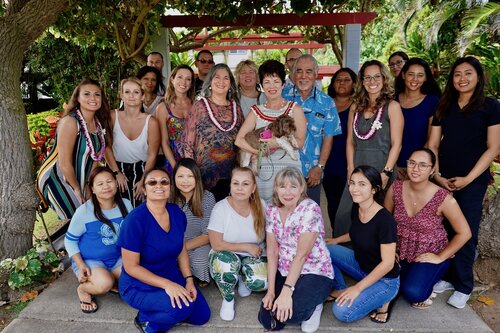Eating disorder recovery is the journey home to your true self.
Learn more about our program from our Director of Eating Disorder Programming, Dr. Anita Johnston, PhD, CEDS.
Treating Body Dysmorphia and Eating Disorders
Body dysmorphia affects approximately 5 million (or about 1 in 50) people in the United States alone [1]. Although individuals without eating disorders can also experience body dysmorphia, Body Dysmorphic Disorder (BDD) is incredibly common among those who struggle with eating disorders. This is why an effective eating disorder treatment program should be equipped to treat body dysmorphia and eating disorders.
What is Body Dysmorphia?
Body dysmorphia is when an individual fixates on imagined or perceived flaws or “defects” in their appearance. In some cases, hours upon hours per day can be spent obsessing over certain parts of features. This obsession can have drastic consequences relating to one’s ability to function in everyday life or to form and maintain relationships. Body dysmorphia can also contribute to, intensify, or prolong an eating disorder.
Body Dysmorphic Disorder is an official DSM-5 (Diagnostic and Statistical Manual of Mental Disorders, fifth edition) diagnosis involving acute distress (physical, mental, or emotional) due to experiencing body dysmorphia.
Today, approximately 1-2% of the general population suffers from BDD. This means about 5 million people in the US alone struggle with the disorder. Unlike many eating disorders, BDD is actually said to affect men and women equally. Although diet culture and social media have had a significant impact on the prevalence of BDD, interestingly, instances of BDD have been documented as far back as medieval times [2].
People with BDD could fixate on the following “flaws” or body parts
Ears
Eyes
Freckles
Scars
Hip or waist size
Nose (too big, crooked, etc)
Skin (pores, wrinkles, etc.)
Chin size or shape
Muscle size and tone
Genital or breast size or shape
Are you in need of treatment today? Talk with a professional now.
Characteristics of Body Dysmorphia
People with BDD are preoccupied with one or more perceived flaws in their appearance. BDD sufferers display varying levels of dislike for their perceived flaws, and can even hate their appearance or themselves. BDD is characterized by the sufferer seeing their body in a distorted way, not as everyone else sees it. It is important to note that these “flaws” are only imagined or are very small and generally not noticed by others. In fact, research has actually revealed that individuals who struggle with BDD actually have irregular visual processing, so these “flaws” are all they can see when they look at themselves. For these reasons, those struggling with BDD may feel confused or alone, or even as though they are being gaslit by their friends and loved ones.
Common signs and symptoms of BDD include:
Attempts to hide or mask certain body parts or “flaws” (clothing, hats, makeup, hair, posture, etc.)
Skin picking
Compulsive mirror checking or grooming
Comparing oneself to others (both in “real life” and people in media)Seeking out elective surgery
Constantly needing or asking for reassurance about one’s appearance from others
Avoidance of mirrors or cameras
Changing outfits multiple times in the morning or throughout the day
One’s mood if significantly affected by clothing
Overexercise, exercising until it feels “just right,” or extreme guilt for not exercising
Seeking Treatment For Body Dysmorphia And Eating Disorders
One may be encouraged to seek treatment for BDD if they are experiencing significant physical, medical, mental, or emotional impacts brought on by their BDD. These symptoms could include: heightened stress, anxiety, or depression; struggling to participate in school or work; loss of relationships; or the development or coexistence of an eating disorder.
Body dysmorphia and eating disorders often go hand-in-hand, but it is important to recognize that there is no such thing as body dysmorphia eating disorder. This said, finding a treatment center that can address body dysmorphia and eating disorders along with other body image issues is vital to many people’s recovery journeys.
At ‘Ai Pono’s Maui location, we are able to provide residential treatment for body dysmorphia and eating disorders. We do this through intensive individual therapy sessions three times per week, process-based group therapy, psychoeducational groups, and various exercises and groups specifically designed to enhance and improve body awareness and acceptance.
Why Treating BDD In An Inpatient Program Can Result In Better Long-term Outcomes
As mentioned above, individuals with body dysmorphia and eating disorders may struggle to accept that what they perceive about their bodies or selves may not be accurate or healthy. Connecting with a community of other individuals who struggle with the same issues provides patients more opportunities for self-reflection and also to challenge their thoughts and actions in a safe and supportive setting.
If one has been struggling with BDD and an eating disorder for an extended period or time, it will take time to begin to challenge and change some of those associated perceptions and fears. Participating in a residential treatment program for anywhere from an average of 45-60 days provides individuals with the time and space to make real change.
Furthermore, those who struggle with body dysmorphia and eating disorders may have seen the symptoms and behaviors related to their eating disorder intensify over time, driven by their inaccurate or distorted perceptions regarding their appearance. Extreme restriction, exercise, or other behaviors may have led to significant health-related impacts that require a multidisciplinary treatment setting in order to safely monitor.
What makes body dysmorphia and eating disorders challenging to treat?
It can be difficult throughout the course of treatment to “tease apart” body dysmorphia and an eating disorder. Also, because someone with BDD may actually have a different way of seeing and perceiving themselves or their bodies, it can be difficult to be open to the input of others or be receptive to treatment in general.
Body dysmorphia typically develops during early adolescence (around 12-13 years of age), and is often missed, dismissed, or misdiagnosed. One of the reasons for this is that people who develop BDD often suffer from other mental health disorders like social anxiety, OCD, depression, or eating disorders. However, even though body dysmorphia might co-occur with these other mental health issues like an eating disorder, BDD is in fact its own disorder and there is no such things as body dysmorphia eating disorder.
The following may serve as barriers in the treatment of body dysmorphia and eating disorders:
Individuals with BDD delay seeking treatment for their disorder out of fear of being dismissed as vain or too obsessed with their appearance.
Someone with body dysmorphia may have a very negative view of themselves or low self-esteem. This can serve as a barrier for treatment as individuals struggling with BDD and an eating disorder may not believe that they deserve recovery or a better quality of life.
One may experience shame over their perceived flaws.
One may feel isolated or confused because their perception of themselves is not aligned with how others perceive them.Family members and friends may lack empathy or understanding, or dismiss the individual with BDD as being vain or “crazy” to see what they see and feel how they feel.
The causes of BDD and eating disorders are a combination of biological and environmental factors. Some of the biological components involved in BDD may include one’s genetic predisposition as well as malfunctioning serotonin in the brain, while contributing environmental factors might include traumatic life experiences such as sexual trauma, childhood abuse, or bullying.
BDD is often also tied to one’s culture, media exposure, and other factors as well, therefore it is important to start by getting a comprehensive picture of how one’s BDD may have begun to develop and how it is related to the eating disorder.
All patients entering our residential treatment for BDD and eating disorders complete a comprehensive medical and psychological assessment prior to admission. These assessments provide us with a detailed account of past and current issues and allow us to build an appropriate and responsive treatment plan that is individualized to the patient’s needs and personal goals.
Here are some effective therapies used in the treatment of body dysmorphia and eating disorders at ‘Ai Pono Hawaii:

Individual therapy to address body image issues and body dysmorphia
In order to support patients struggling with body dysmorphia and eating disorders, therapeutic work must focus on reconnecting and healing one’s relationship with their body. It is also important to learn about and discuss the impacts of culture, family background, etc. on the shaping of one’s self image and how to distinguish one’s healthy or true values from those that have been forced upon us via external sources. These topics can be addressed in detail through multiple sessions with an individual therapist each week.
Individual psychotherapy for treating body dysmorphia and eating disorders focuses on both cognitive therapy (teaching patients to identify and replace their negative thoughts with positive ones) and behavioral therapy (similar to the cognitive therapy approach but focusing on behaviors instead of thought patterns).
Group and family therapy
It’s important for families and support systems to understand BDD and recognize its symptoms so they can better support the patient’s recovery, so family or group therapy is often recommended as part of the treatment process.
Group therapy is also incredibly helpful to enable patients to counteract the shame and isolation they may feel as a result of their struggles with body dysmorphia and eating disorders as well as provide a platform for therapeutic challenges or “reality checking.”


Support of a Multidisciplinary Team
Sometimes, antidepressant medications like SSRIs may be prescribed to help relieve the patient’s compulsive symptoms. At ‘Ai Pono Hawaii, our Medical Director, Dr. Brian Teliho, is a skilled psychiatrist who provides in-depth psychiatric consultation to determine if medication could enhance or improve a patient’s outcomes.
incorporating Body-based therapies
Patients at ‘Ai Pono’s Maui location engage in various groups and activities designed to enhance body awareness, proprioception, and grounding. Groups such as Body Awareness, Ecstatic Dance, and Mindfulness help patients to explore their bodies as they relate to others and the space around them.
We also facilitate gentle yoga twice weekly and mindful walks in order to re-explore and reimagine how we can move our bodies in supportive and nurturing ways.


Cultivating intuition as part of the recovery process
Intuition is a therapeutic topic that is often discussed and worked upon at the Maui Residential Program. Intuition involves learning to trust ourselves and our feelings to guide us towards overall health and balance. Practicing skills such as emotional awareness, emotional regulation, and assertive communication along with engaging in group therapy allow patients to regain trust and confidence in their own ability to care for themselves with love, compassion, and understanding.
We also offer a wide variety of therapeutic and recreational groups such as:
Dialectical Behavioral Therapy Skills Groups focusing on assertive communication and emotional literacy
Narrative Therapy/Storytelling
Full Moon Letting Go/Intention Setting Gatherings
Visits to Nature and Cultural Sites
Nature Therapy
Hawaiian Cultural Groups
Art Therapy
…and more!
These unique offerings provide patients with a genuinely holistic treatment experience and different avenues through which to identify and work through the meaning behind their struggles with body dysmorphia and eating disorders in order to find true, sustainable healing.
Treating Body Dysmorphia and Eating Disorders at Various Levels of Care
‘Ai Pono Hawaii, we recognize the range of challenges faced by people who struggle with eating disorders. These struggles are only made more complicated if one also struggles with body dysmorphia. Both eating disorders and body dysmorphia can lead to significant negative impacts on one’s mental and physical health and overall quality of life.
Fortunately, at ‘Ai Pono Hawaii we offer different treatment options for patients who are ready to embark on the journey to recovery from body dysmorphia and eating disorders.
Please note: As part of our comprehensive pre-admissions process, we offer free phone assessments in order to determine what level of care is most appropriate for each patient’s presenting needs. Reach out to us today to complete an assessment.
Residential Treatment
‘Ai Pono Hawaii offers a truly holistic residential treatment for women struggling with body dysmorphia and eating disorders that addresses patients’ nutritional, medical, and therapeutic needs. Our skilled treatment team is available 24/7 to provide individual support for patients. We offer one-on-one psychotherapy sessions three times per week, as well as intensive trauma treatment for those struggling with underlying or co-occurring trauma. We also provide family therapy sessions for all adolescent patients and encourage the involvement of family or support systems for all patients.
*This program has resumed normal operations. For more information, please read our latest COVID-19 guidelines.
INTENSIVE OUTPATIENT TREATMENT (IOp)
Our Intensive Outpatient Program (IOP) is a unique type of treatment offered to people of all genders who are struggling with body dysmorphia and eating disorders. This program takes place for 3 hours each session and involves various services including group psychotherapy, nutritional education, and meal support for three (3) to seven (7) days per week based on the patient’s unique treatment plan. We provide our IOP both in-person at our Maui Residential Program as well as virtually for all Hawaii residents.
*As of this time, this program is only available virtually for residents of Hawaii.
In search of a Treatment Center that can effectively address Body Dysmorphia and Eating Disorders? We can help.
It can often be difficult to receive a proper diagnosis and treatment for body dysmorphia and eating disorders. One of our first pre-admissions steps is to complete a free level of care assessment in order to learn more about your specific symptoms and how we might be able to support you in your search for support and healing. We also support you in completing a medical clearance, so that we can evaluate your eating disorder and its symptoms wholly, from a behavioral and medical perspective. Reach out to us today if you have been diagnosed with BDD or identify with the symptoms of body dysmorphia and eating disorders.
[1] https://bdd.iocdf.org/professionals/prevalence/
[2] https://adaa.org/learn-from-us/from-the-experts/blog-posts/consumer/mirror-mirror-wall
